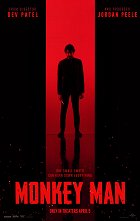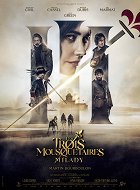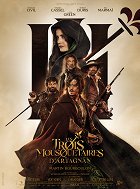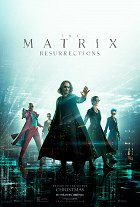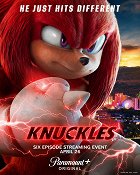Action - Genres
Hottest on VOD Today
Basic characteristics of action films
The term "action film" is defined as a fictional genre that features one or more protagonists who are repeatedly confronted with a number of fights, shootouts, chases, or other wild and dangerous situations that put their lives at risk. Action films therefore often contain violence, guns, killing and physical suffering, or even explosions and epic scenes of destruction. In addition to intrepid heroes who plunge into the action for personal motivations, to fulfil a mission, to save innocents or to prevent the enemy from doing evil, and usually succeed in their endeavour despite the unlikely chance of victory, many action films also feature villains and their henchmen, who put various obstacles in front of the heroes and complicate their actions in various ways.
Action scenes have appeared in films since the beginning, but it wasn't until the 1970s that action films began to emerge as a genre in their own right, helped significantly by the rise of special effects. The profession of stuntmen, who specialise in all sorts of tricky and dangerous activities, is also strongly associated with action films, they stand for the actors during the shooting of scenes in which untrained individuals could at least be at risk of injury. Many actors playing leading roles have become movie stars and genre icons and have been cast repeatedly in films of the same genre. In the 1990s, computer generated special effects were added, later leading to films in which most of the action is digital. Action films often merge with other genres, typically thrillers, science fiction, and adventure or historical films, while action and shooting is also present in most westerns and war films.
Forerunners of action films
The first action scene in film history is the train robbery in the ten-minute The Great Train Robbery (1903), considered not only the first western, but also the first action film as such. In the 1920s and 30s, in addition to a number of cheap westerns, action scenes were included mostly in adventure films whose heroes fought with swords or cutlasses. Typical representatives are The Mark of Zorro (1920), The Three Musketeers (1921), Robin Hood (1922), The Thief of Bagdad (1924), and The Black Pirate (1926), starring Douglas Fairbanks, the first action film star. He was succeeded by Errol Flynn, who starred in Captain Blood (1935) and The Adventures of Robin Hood (1938), while Tyrone Power became a star thanks to Jesse James (1939) and The Mark of Zorro (1940).
From the 1940s onward, westerns dominated the action genre in Hollywood, peaking in the 1950s when Wild West cowboy stories dominated all other film production in the USA, and only in the 1960s did it begin to decline significantly. The action icons of the time were John Wayne, James Stewart, Gary Cooper, William Holden and other western stars. But war films and spy thrillers were also very popular at the same time. The 1950s saw a wave of action samurai films in Japan, and their leading figure, director Akira Kurosawa, became famous for the likes of Seven Samurai (1954), Yojimbo (1961) and Sanjuro (1962), all starring his court actor Toshiro Mifune. Italy in 1960s produced spaghetti westerns, and their most prominent personality was director Sergio Leone, whose trilogy A Fistful of Dollars (1964), For a Few Dollars More (1965) and The Good, the Bad and the Ugly (1966) made a household name of Clint Eastwood, who later went from a western legend to a star of action crime-thrillers.
The Great Train Robbery (1903)
Photo © Edison Manufacturing Company
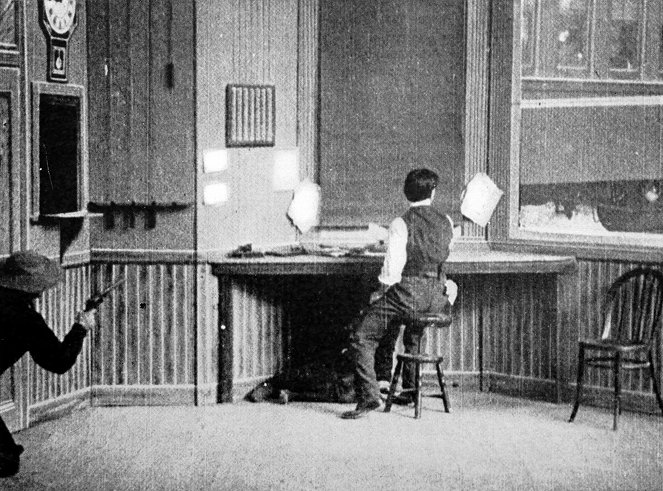
James Bond and American action crime films
Starting in the first half of the 1960s with Dr. No (1962), the Bond films became a huge hit. They were action spy thrillers inspired by Ian Fleming's books about a British secret agent with a 007 code and a license to kill, who tries to thwart the evil plans of numerous villains. The popular hero James Bond, who enjoys expensive cars and beautiful women, was first portrayed by Sean Connery, who would later be replaced by George Lazenby, Roger Moore, Timothy Dalton, Pierce Brosnan, and Daniel Craig. Bond films offered audiences unprecedented car chases, fist fights, fast editing, lots of special effects, numerous weapons and technological advances, and the archetype of the indestructible action hero bravely going up against the odds while spouting dry wisecracks, thus beginning the era of modern action films.
In America at the turn of the 1960s and 70s, the action film genre evolved into dirty urban movies built on crime and detective plots that were actually more about gunfights and car chases with criminals than police investigations. Those elements were made famous by Bullitt (1968), in which a police lieutenant played by Steve McQueen searches for the killers of a gangster who had defected from a mafia organisation, or the realistically raw The French Connection with Gene Hackman (1971), about a pair of detectives on the trail of heroin traffickers. They were followed by, among others, The Taking of Pelham One Two Three (1974) and Assault on Precinct 13 (1976).
Clint Eastwood fit easily into the same milieu as a cynical policeman tasked with catching a mysterious sniper in Dirty Harry (1971), the success of which spawned four sequels and an era of fascination with firearms, and also gave rise to the character of an unyielding law enforcer who disregards regulations and superiors in pursuit of his goals, thus influencing the heroes of many other action films. Charles Bronson similarly made a name for himself as a controversial self-appointed vigilante in the Death Wish series of action thrillers (from 1974). In addition, this period also saw the release of trashy action exploitation films (e.g. Faster Pussycat... Kill! Kill! from 1965) and blaxploitation action films (e.g. Shaft from 1971 or Dolemite from 1975).
Dr. No (1962)
Photo © United Artists
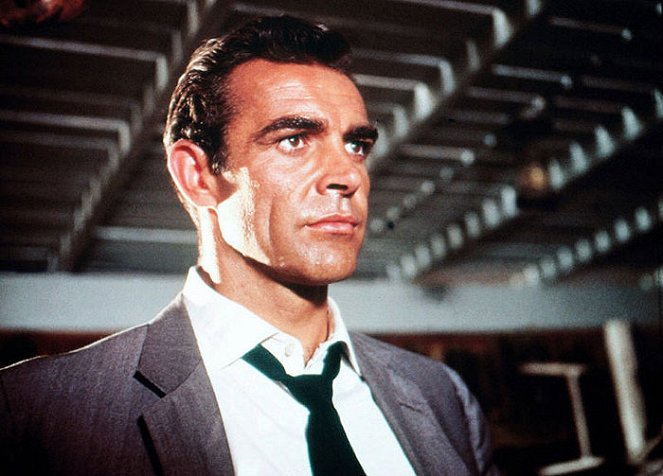
Hong Kong Fight Movies
The creation of action films in Hong Kong first took the form of mystical films belonging to the wuxia genre, which was based on traditional Chinese stories about revered martial arts masters who defended justice with sword in hand. This trend was eventually replaced by the era of kung-fu films, whose heroes were much more down-to-earth representatives of the common people and used their fists instead of weapons. In addition to the many actors who excelled in martial and acrobatic skills starring in a series of movies called "martial arts films", which captivated audiences with their detailed choreographies of contact fights and action scenes, the Shaw Brothers production studio also greatly popularised the kung-fu film genre, especially in the 1960s. The action scenes in these films became famous for the use of wires, trampolines and other devices that gave the heroes almost superhuman abilities.
The peak of Hong Kong filmmaking took place between the 1970s and 90s, when it established narrative motifs and techniques that Hollywood filmmakers eventually tried to adapt. One of the directors who headed to Hollywood was John Woo, who had previously enjoyed a number of successes in Hong Kong as the founder of the "heroic bloodshed" genre, which consisted of having dozens to hundreds of people gunned down in his films about assassins, gangsters and policemen fighting mafia triads, despite their nature as convinced pacifists. He also discovered and made famous the television actor Chow Yun-Fat, whom he cast in A Better Tomorrow (1986), A Better Tomorrow II (1987), The Killer (1989) and Hard Boiled (1992), and who also appeared in the lead roles of Prison on Fire (1987) and Full Contact (1992).
In the films Magnificent Butcher (1979), Winners & Sinners (1983) and Eastern Condors (1987), the lead roles were played by Sammo Hung; Biao Yuen was cast in leading roles in Knockabout (1979) and Above the Law (1986), among others, while Iron Monkey (1993) is the most famous Hong Kong film of Donnie Yen's early career. The leading action heroines in Hong Kong cinema at the time include Moon Lee, who made a big splash in Angel Force (1990), the Iron Angels (1987) and the Killer Angels (since 1989) film franchise, and Michelle Yeoh, who starred in Royal Warriors (1986) and Easy Money (1987), and became Hong Kong's highest-paid actress when she starred alongside Jackie Chan in Police Story 3: Supercop (1992). Other notable representatives of Hong Kong action cinema include 5 Fingers of Death (1972), 5 Masters of Death (1974), The Five Venoms (1978), Legendary Weapons of China (1982) and The 36th Chamber of Shaolin (1978), one of the last of the old-style kung-fu films, after which digital effects began to dominate action scenes in the 1990s replacing traditional wires.
Hard Boiled (1992)
Photo © Mei Ah Entertainment
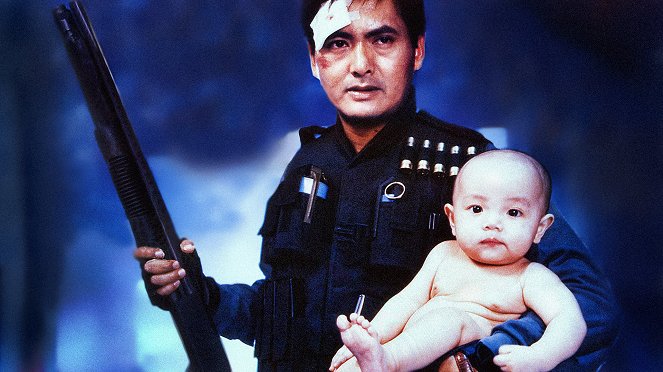
Bruce Lee, Jackie Chan and Jet li
In the 1970s, Hong Kong's biggest star was Bruce Lee, whose first major films, Fists of Fury (1971) and The Chinese Connection (1972), in which he portrays a martial arts student who decides to avenge the death of his master, were hugely successful and made him a legend who started the trend of using his own body as a weapon in action films. His directorial debut, The Way of the Dragon (1972), in which he cast himself as the protector of Italian restaurant owners from the Mafia, was also a hit. But his promising career was cut short by his untimely death, after which the studios struggled to find a suitable replacement in Lee impersonators such as Bruce Li and Bruce Le. Fortunately, a few years later, Jackie Chan, who started as a stuntman in Bruce Lee's films, came to the fore, and, starting with Eagle's Shadow (1978), established himself as the protagonist of kung-fu action comedies. His most famous films include Police Story (1985), where he plays a police officer charged with protecting a witness in the case of an arrested drug dealer, Armour of God (1986), where he fights as a treasure hunter against the guardians of an ancient city and a mythical weapon, and Legend of the Drunken Master (1994), where the hero fights better the drunker he gets. From the mid-1980s onward, Jackie Chan also starred in US-Hong Kong co-productions and in the 1990s he fully launched his career in the US.
Chinese national treasure Jet Li first appeared in the first instalment of the narrative trilogy The Shaolin Temple (from 1982), in which he captivated with the purity of his fighting technique, catapulting him to Hong Kong. In Dragon Fight (1989) he plays a fighter who has to deal with the fact that his friend and colleague has joined the Mafia in the USA. He became a star in the epic Once Upon a Time in China (1991), where he fights against foreign oppression as a Chinese folk hero, a doctor and an invincible warrior; it was a huge hit and was followed by many sequels. In 1994, Jet Li was cast in a remake of The Chinese Connection called Fist of Legend, and he would go on to start in fight films in America (Romeo Must Die, 2000) and France (Kiss of the Dragon, 2001), eventually ending up shuttling between the US, Hong Kong and his home country of China.
Return of the Dragon (1972)
Photo © Golden Harvest Company Ltd.

Sylvester Stallone and the muscleman era
In the 1980s, considered the golden age of action cinema, Hollywood produced a series of films characterized by volleys of bullets and fiery explosions, while at the same time creating the prototype of the action hero in the form of a rugged macho man with a well-developed body and a sufficiently large arsenal. These invulnerable musclemen, strong as an entire army, represented a return to masculine virility after the end of second-wave feminism in the early 1980s, and equally served as a means of restoring confidence to an American society scarred by the Cold War, a Ronald Reagan administration that divided the world into good Americans and evil Soviets and Communists, and a lost war in Vietnam.
The role of the heroic American patriot in this respect was played primarily by Sylvester Stallone, who famously broke through with the lead role in the Oscar-winning boxing film Rocky (1976), whose realistic tale of an underdog seeking the heavyweight title of the world was transformed into a patriotic spectacle in the third sequel, Rocky IV (1985), in which the American champion Rocky defends his title against a Russian enemy symbolizing the entire Soviet Union. The Rambo franchise went through a similar transformation. The first instalment, First Blood (1982), was a raw thriller about a Vietnam veteran unable to adjust to normal life after returning home and pitted a police unit against him, while its sequel, Rambo: First Blood Part II (1985), was an explosive action inferno on Vietnamese soil, with the title character blasting his way through dozens of Communist enemies with firearms and excessive force, curing the nation's ills off-screen.
The Rocky and Rambo franchises kick-started Stallone's by then miserable acting career and over the years have spawned a number of sequels, some of which Stallone himself directed. In the action thriller Cobra (1986), Stallone plays a lone cop on the trail of a serial killer, in Tango & Cash (1989) he fights a gangster boss with a police partner played by Kurt Russell, and in the action thriller Assassins (1995) he was joined by Antonio Banderas as a hitman. As a mountain guide in Cliffhanger (1993), he has to deal with a group of criminals looking for lost loot, and in the sci-fi films Demolition Man (1993) and Judge Dredd (1995), he visited different visions of the future. By the turn of the 1980s and 90s, however, Stallone had moved on to more moderate roles without ever losing his reputation as an action legend, and he even made several notable comebacks in the following years.
Rambo: First Blood Part II (1985)
Photo © Carolco Entertainment
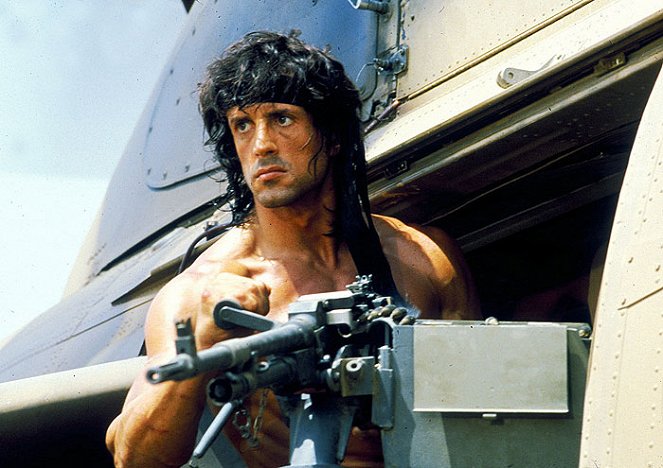
Arnold Schwarzenegger the muscleman era II
Arnold Schwarzenegger, originally an Austrian bodybuilder, achieved similar success around the same time, rising from appearing in gym documentaries and a few supporting roles to become the most adored star of the 1980s. His breakthrough came in 1982, when he wielded a sword from the mythical Atlantis in a loincloth in the lead role of the fantasy film Conan the Barbarian, and then shot to the heavens in James Cameron's action sci-fi film The Terminator (1984), in which he is sent into the past as the ultimate killer robot to kill the mother of the future leader of the Resistance in the coming war against the machines. Its sequel, Terminator 2: Judgment Day (1991), was revolutionary in terms of its use of digital effects, was the most expensive film ever at the time, made an action heroine out of actress Linda Hamilton, was nominated for six Academy Awards, and still ranks among the best action and science fiction films in cinema history. Violent action and funny catchphrases were combined in Commando (1985), in which Arnold rescues his kidnapped daughter and fights the private army of an island dictator with endless ammunition, as well as pitchforks and circular discs, while Predator (1987), directed by John McTiernan, pitched him against a monstrous alien hunter, and also became a cult hit.
After that, Arnold Schwarzenegger starred in the dystopian action sci-fi film The Running Man (1987), about convicts who can gain their freedom by participating in a brutal reality TV show, and in the action thriller Red Heat (1988), where he plays an uncompromising Soviet police captain searching for an international convict in the USA. In Paul Verhoeven's sci-fi film Total Recall (1990), about the border between reality and fiction, he takes on the role of a worker confronted with his past as a secret agent during his vacation on Mars. Reality and the world of fiction were also combined in the comedic Last Action Hero (1993), in which a twelve-year-old boy falls into the world of action movies. James Cameron's self-ironic thriller True Lies (1994) turned Arnold into a secret agent posing as a boring businessman in front of his wife, and Eraser (1996) stretched him through the oft-worn theme of a witness protection specialist. Arnold Schwarzenegger would return to action films after putting his acting career on hold for several years due to politics and his position as governor of California.
Commando (1985)
Photo © 20th Century Fox
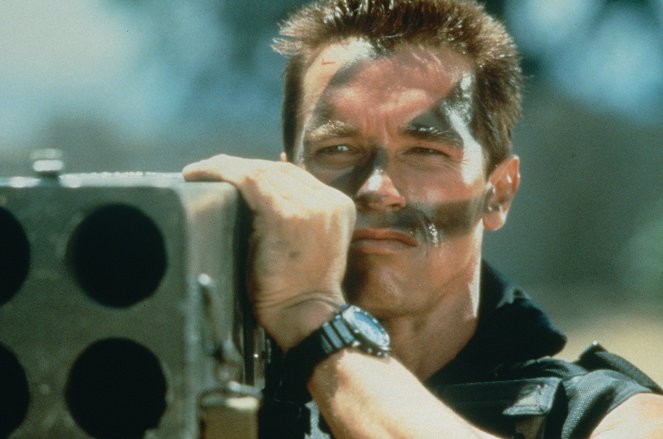
Van Damme, Norris, Seagal, Lundgren and the era of the musclemen III
The wave of Hong Kong fight films influenced American action cinema from the 1970s to the 90s, and the popularity of the genre allowed a number of successful Asian filmmakers and actors who had emigrated due to fears of Hong Kong's annexation to China to launch their careers in the West. Moreover, producers tried to find another little-known actor like Bruce Lee and make him a star. Karate champion Chuck Norris, who played Bruce Lee’s antagonist in The Way of the Dragon, showed great potential, and he would go on to star in several action films, including A Force of One (1979), An Eye for an Eye (1981), and later played the main role in the action-packed Missing in Action (1984), Invasion U.S.A. (1985) and The Delta Force (1986), which served the same function as Rambo: First Blood Part II. However, none of them was an outright hit, and Norris became a cult star only thanks to the TV series Walker, Texas Ranger (from 1993) and a few years later thanks to internet humour. Much more successful in this respect was the career of the Belgian-born karate master Jean-Claude Van Damme, who brought the motif of arena fighting to the American action genre and enriched the fights with his famous balletic kicks and spins.
A turning point in his career was Bloodsport (1988), in which he plays the lead character as an American who travels to Hong Kong with the aim of winning a martial arts tournament. Other big hits were Kickboxer (1989), in which he plays a man who takes up the apprenticeship of a kickboxing master in order to avenge his brother who was crippled in the ring by a Thai opponent, Double Impact (1991), in which he plays a double role, the action sci-fi film Universal Soldier (1992), where he became a cyborg, Hard Target (1993), in which he was cast as an exterminator of sadists who organize homeless manhunts for fun, and the sci-fi movie Timecop (1994), whose hero is an agent enforcing a ban on time travel. The Swedish national karate team captain and science degree holder Dolph Lundgren, who became famous for his role as the antagonist in Rocky IV (1985) and subsequently appeared in the lead roles of Red Scorpion (1988), The Punisher (1989), Dark Angel (1990), Showdown in Little Tokyo (1991) and Joshua Tree (1993), most of which were very unsuccessful, also made a significant impact in Universal Soldier.
Martial arts master and black belt Steven Seagal, who had learned from masters in Japan, also achieved considerable fame. He first appeared in the successful action film Above the Law (1988) and his career took off with the subsequent crime hits Hard to Kill (1990), Marked for Death (1990) and Out for Justice (1991), in which he plays the roles of police officers and undercover agents battling hitmen, mobsters and drug gangs. His best film is considered to be Under Siege (1992), where he fights the terrorist hijackers of a nuclear battleship as a soldier demoted to cook. On Deadly Ground (1994), in which he plays an oil well explosion specialist, was also his directorial debut. In the second half of the 1990s, however, all of these actors suffered a similar fate: along with the fluctuating and steadily declining quality of their films, they retained the goodwill of only their most loyal fans, and even though they attempted a glorious comeback here and there, and some of their cheesy B-movie ventures were successful on video, they gradually faded away.
The Delta Force (1986)
Photo © Metro-Goldwyn-Mayer
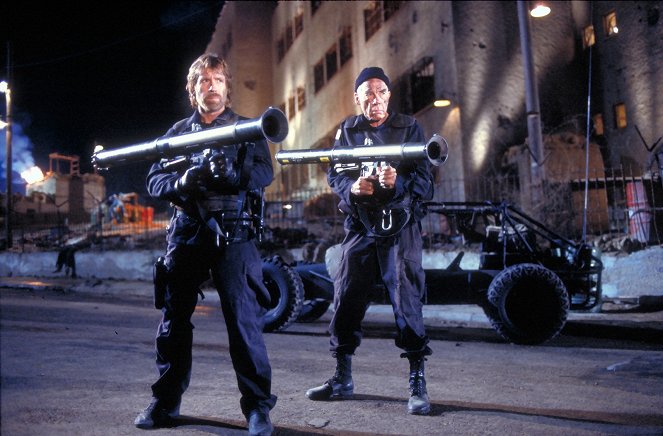
Other action hits of the 1980s
Director Walter Hill, who made The Warriors, a 1979 film about street gang wars, picked up on the dirty-city vibe with Streets of Fire (1984) and directed 48 Hrs. (1982) with Eddie Murphy and Nick Nolte, starting the vogue for action-packed buddy cop comedies. Eddie Murphy rode this sub-genre in the Beverly Hills Cop series (from 1984) and later in Metro (1997), while the Lethal Weapon franchise (from 1987), starring Mel Gibson and Danny Glover, also became very successful. Mel Gibson had previously made a name for himself with the Australian post-apocalyptic trilogy Mad Max (from 1979), depicting the fate of a former police officer fighting motorcycle gangs. Dystopian visions of the future were also explored in John Carpenter's action films Escape from New York (1981) and Escape from L.A. (1996), set in a prison colony in Manhattan. Carpenter cast Kurt Russell for both films, and also in Big Trouble in Little China (1986), which combined humour, action and martial arts with fantasy themes based on Chinese folklore.
James Cameron took the horror sci-fi film Alien and made its much more action-packed sequel, Aliens (1986), which at the time stood out as one of the few films starring an action heroine played by Sigourney Weaver. The highest-grossing film of that year, though, was Tony Scott's Top Gun, starring Tom Cruise, which was made in collaboration with the US Navy, was inspired by the aesthetics of MTV music videos, and used aerial sequences with fighter jets to advertise the military. Actor Michael Dudikoff succeeded in the lead role of the American Ninja film series (from 1985), while The Karate Kid (1984) was a family-friendly variation of fighting films. Paul Verhoeven scored with RoboCop (1987), a gritty sci-fi tale of a cybernetic police officer uncompromisingly bringing order to a world dominated by corporations and crime, and a decade later with the satirical Starship Troopers (1997), which took on war propaganda in a story about humanity's battles with alien bugs.
Lethal Weapon (1987)
Photo © Warner Bros.
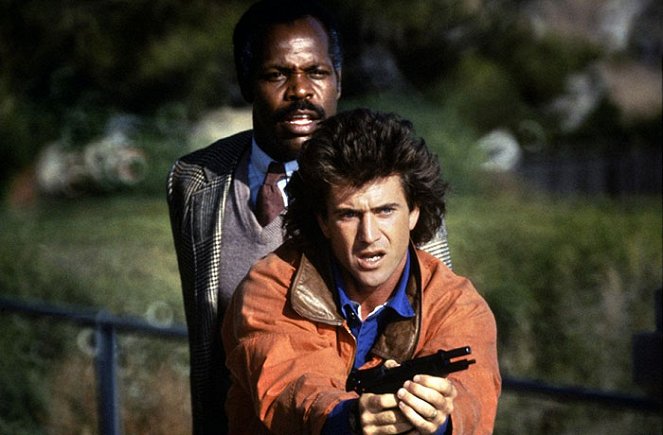
Bruce Willis and the transformation of action films
In the late 1980s, director John McTiernan came up with a new type of action hero that represented a return to traditional American values, largely replacing the invulnerable muscle icons of previous years that had come to symbolize Reagan's power politics. In Die Hard (1988), Bruce Willis made his mark as a police detective who becomes an unwilling combatant against terrorists holding several hostages, including his wife, in an unfinished skyscraper. Willis's hero bled, made mistakes, and had both fear and insight; he wasn't an action superman or a killing machine. Die Hard became a new-age action film, spawned several sequels, made Bruce Willis a sought-after star, and is still considered one of the best action films ever made.
In Tony Scott's The Last Boy Scout (1991), Willis plays a bitter and unsuccessful detective whose complex case with a political background helps him regain his wife and his faith in himself and the world around him. However, not wanting to be type-cast in the role of an action hero for too long, he launched his career across genres, returning to action several times in the 1990s, including as a police officer in Striking Distance (1993), as an assassin in the thriller The Jackal (1997), as a general in The Siege (1998), as an FBI agent in Mercury Rising (1998), and as an oil driller tasked with destroying an asteroid approaching Earth in the catastrophic sci-fi movie Armageddon (1998), whose director, Michael Bay, had previously made a successful debut with Bad Boys (1995) and later earned a reputation as a genre icon thanks to a series of explosive and dazzlingly effective action films.
Die Hard (1988)
Photo © Twentieth Century Fox

Other action hits of the 1990s
In terms of the action genre, the 1990s in Hollywood were marked by the continuation of successful films from previous decades and the adoption of proven themes. Sylvester Stallone and Arnold Schwarzenegger began to slowly fade away in the cinemas screens, while fighters like Van Damme, Seagal and Lundgren disappeared straight to video and later to DVD, and were replaced by new age action heroes. A year after winning the Academy Award, Nicolas Cage appeared in the lead role in Michael Bay's The Rock (1996), then starred in the action thriller Face/Off (1997), directed by John Woo, who had since settled in America for a time, and in Con Air (1997), in which he plays a convict awaiting release as a passenger on a plane that is unfortunately hijacked by his cellmates, and finally in the motor oil-scented Gone in Sixty Seconds (2000), in which he plays a former car thief forced to return to the business. Harrison Ford, whose reputation as an action star dates back to Star Wars (1977) and Raiders of the Lost Ark (1981), starred in the successful action thrillers Patriot Games (1992), The Fugitive (1993), Clear and Present Danger (1994), and Air Force One (1999), in which he was cast as a surprisingly hard-hitting President of the United States.
Keanu Reeves earned praise as a secret agent infiltrating a group of thieving surfers in Point Break (1991), as an explosives expert tearing up the streets with a bus that can't stop in Speed (1994), and most importantly as a digital messiah in the revolutionary sci-fi film The Matrix (1999), in which the action and fight scenes were in charge of a leading choreographer of Asian kung-fu films. Tom Cruise made a name for himself in the successful action-spy film franchise Mission: Impossible (since 1996), which became famous for its adrenaline-fuelled escapades of secret agents completing seemingly impossible missions. In the USA, Jackie Chan established himself in action comedies, including Rush Hour (1998) and Shanghai Noon (2000).
Other hits include John McTiernan's The Hunt for Red October (1990), Michael Mann's Heat (1995), the video game-inspired Mortal Kombat (1995), the catastrophic Independence Day (1996), the horror film Blade (1998), which made famous Wesley Snipes as a vampire slayer, and The Big Hit (1998), which mad an action star out of Mark Wahlberg. The Charlie Sheen action comedies Hot Shots! (1991) and Hot Shots! Part Deux (1993) parodied famous action films of the 1980s, in the first case mainly Top Gun and in the second Rambo: First Blood Part II and Commando. Ronin (1998), an action film co-produced by the UK and France, was famous for its car chases.
The Rock (1996)
Photo © Hollywood Pictures
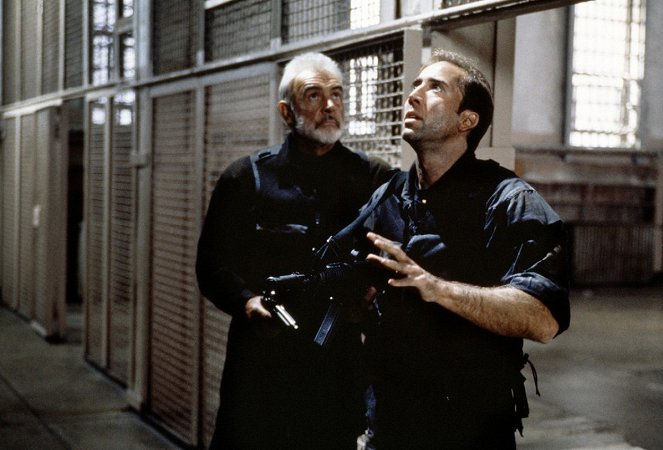
Luc Besson and French action films
In addition to the UK, which gave the world James Bond, France is one of the few European countries with a tradition in the action genre, with crime thrillers and action comedies starring Alain Delon and Jean-Paul Belmondo as the prototype of the action film from the 1960s to the 1980s. Alain Delon played a bandit in the adventure The Black Tulip (1964), a desperado in the western Red Sun (1971), where he was accompanied by foreign action stars Charles Bronson and Toshiro Mifune, and an avenger in Zorro (1975). After that, he became famous for his roles in the crime films The Twisted Detective (1977), Three Men to Kill (1980), Cop's Honor (1985), and Let Sleeping Cops Lie (1988). Jean Paul Belmondo became an icon of French cinema thanks to his roles as charming thieves, adventurers, policemen and secret agents. He took part in a truck chase in Greed in the Sun (1964), played the role of a writer and his fictional alter-ego as an elite super-agent in The Man from Acapulco (1973), and took on the role of a film stuntman in the action comedy Animal (1977). He also made a name for himself in the action crime films Fear Over the City (1977), Hunter Will Get You (1976), Cop or Hood (1979), and The Professional (1981). Both actors met in the action comedy Half a Chance (1998), in which they took on the Russian mafia, accompanied by actress Vanessa Paradis.
French action cinema in the 1990s was heavily influenced by Luc Besson, who in 1990 made Nikita, about a young junkie who, after being arrested, joins the secret service, where she is trained to be the perfect agent and assassin. He then repeated his success with Léon: The Professional (1994), in which actor Jean Reno became famous for his role as professional assassin. During his career, Besson also became known as a prolific writer and producer of action films by other directors. He wrote the action series The Transporter (since 2002), which made a star out of British actor Jason Statham, the Taken trilogy (since 2008), in which Liam Neeson took on the role of the action hero, and the comedy saga Taxi (since 1998), about an extreme taxi driver. Besson's credits also include the action comedy Wasabi (2001), the fight films Kiss of the Dragon (2001) and Unleashed (2005), in which Jet Li shows off his martial arts skills, District 13 (2004) and its remake Brick Mansions (2014), and Colombiana (2011), starring Zoe Saldana as the titular assassin. He returned to directing action films in, among others, the sci-fi movie Lucy (2014) and the thriller Anna (2019).
The Professional (1981)
Photo © Les Films Ariane
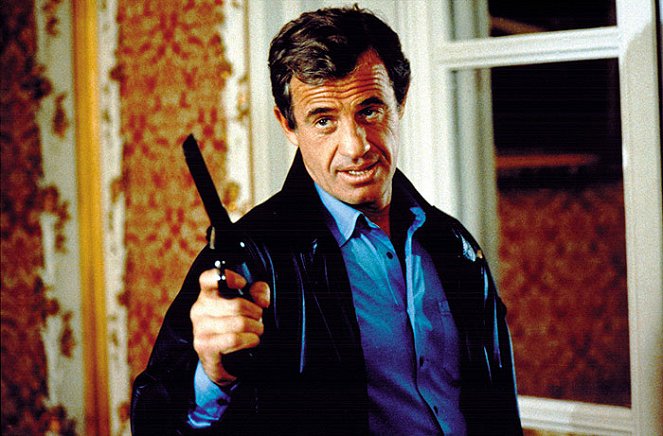
Asian action films of the new millennium
After the decline of Hong Kong cinema in the 1990s, the action genre in Asian countries faded considerably and only revived with the turn of the millennium, when director Ang Lee made Crouching Tiger, Hidden Dragon (2000), a co-production between China, Taiwan and Hong Kong, as an epic homage to the traditional wuxia genre, casting action film legends Chow Yun-Fat and Michelle Yeoh, as well as rising action star Ziyi Zhang. The huge international success of this four Oscar-winning film, whose story combined themes of unfulfilled love and poetic sword fights, led to the birth of similarly themed films, most notably Hero (2002, starring Jet Li), House of Flying Daggers (2004) and Curse of the Golden Flower (2006). The historical combat film The Rebel (2006), set during the French occupation in the 1920s, was made in Vietnam and was at the time the most expensive film ever made in that country. In Thailand, the actor Tony Jaa gained international fame thanks to the nationalist film series Ong-bak: The Thai Warrior (since 2003), in the first episode of which he performs martial arts and acrobatic stunts as a villager who goes to the big city to find the thief of a sacred statue. The Thai film Chocolate (2008) also attracted attention with its story about a female warrior who can perfectly imitate any martial art.
Hong Kong continued the tradition of fighting films with, for instance Kill Zone (2005), starring Donnie Yen and Sammo Hung as a principled cop and a mob boss, and Fearless (2006), starring Jet Li as a fighter whose family is the target a blood feud after killing an opponent, and the historical film series Ip Man (from 2008), whose hero, a Chinese martial arts master who takes on the Japanese occupation, became the most famous character of Donnie Yen's career. The Hong Kong action comedies Shaolin Soccer (2001) and Kung Fu Hustle (2004) also did well in the international market with a combination of martial arts and absurdist humour. In contrast, the South Korean action-revenge thriller Oldboy (2003), the gritty action drama Silmido (2003), inspired by an assassination attempt on the Korean president, The Man from Nowhere (2010), whose protagonist's murderous past enables him to protect a little girl from the mafia, and the zombie-invasion action thriller Train to Busan (2016), the highest-grossing South Korean film of all time, all produced chills instead of laughter.
Japan created a world event out of the dystopian action thriller Battle Royale (2000), in which high school students are herded into a killer reality show on an isolated island. Actor and director Takeshi Kitano was successful at festivals with his film The Blind Swordsman: Zatoichi (2003), in which he plays the legendary character of a blind warrior. Another successful film was Thirteen Assassins (2010), a remake of the 1963 Japanese film of the same name. Indonesia also made a significant impact in the field of martial arts films with Merantau Warrior (2009), starring Iko Uwais and directed by British-born Gareth Evans as his Indonesian debut, who then made with the same actor the celebrated action film The Raid: Redemption (2011), which was one long and intense action sequence about a police raid on a gangster-ridden apartment block. Its sequel The Raid 2 (2014) was different, taking the route of a gangster epic full of fight scenes. Iko Uwais would go on to star in the brutal Indonesian action films Headshot (2016) and The Night Comes for Us (2018).
Crouching Tiger, Hidden Dragon (2000)
Photo © Sony Pictures Classics
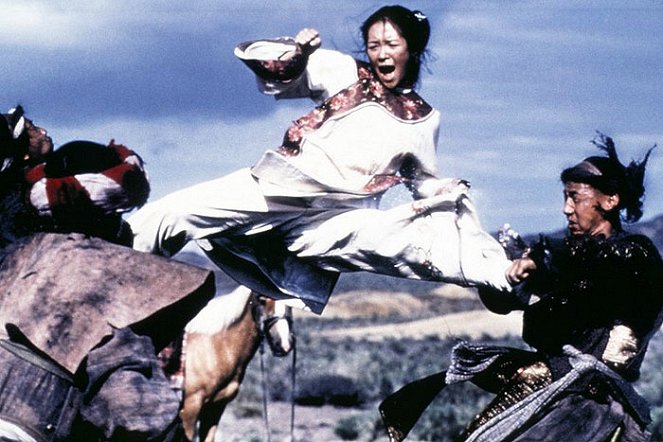
Action films after 2000
The action genre has often intertwined with other genres, especially science fiction, thrillers, adventure and fantasy, and this would be common practice after the turn of the millennium, while pure action films became a relatively rare phenomenon. Films that can be considered part of the action genre include all Star Wars sequels and the newly rebooted Star Trek (since 2009), many comic book and superhero films, the video game-inspired Resident Evil franchise (since 2002), and The Matrix sequels: The Matrix Reloaded (2003) and The Matrix Revolutions (2003). Among classic action films, the French-produced series The Transporter (since 2002) and Taken (since 2008) have taken hold in the US and elsewhere in the world, as well as the newer Bond films, which took on a new breath and added grit and realism with another change of protagonist in Casino Royale (2006). The spy series Mission: Impossible with Tom Cruise also kept its finger on the pulse of the times, increasing the amount of adrenaline in the action sequences with each episode.
The hero Jason Bourne, played by Matt Damon, also made a name for himself in the action spy thriller genre, having searched for his identity in The Bourne Identity (2002), The Bourne Supremacy (2004), The Bourne Ultimatum (2007) and Jason Bourne (2016). A trio of secret agents starring Cameron Diaz, Drew Barrymore and Lucy Liu gave us the comedy Charlie's Angels (2000). The Fast and the Furious film franchise (from 2001) became extremely profitable, brimming with car chase scenes and making a star out of Vin Diesel, who would shine in the action thriller xXx (2002). The multi-part saga of The Fast and the Furious picked up speed with Fast Five (2011), which added more absurdity to the action sequences and brought in Dwayne Johnson, a former wrestler nicknamed The Rock who had previously appeared in the action films The Rundown (2003), Walking Tall (2004) and Faster (2010). Furious 6 (2013) added Jason Statham, who, in addition to The Transporter franchise, had also starred in the action films The Italian Job (2003), Crank (2006) and Death Race (2008). Movies with arena fights survived in the form of the Undisputed series (from 2002), which gained momentum with the MMA-inspired sequels Undisputed II: Last Man Standing (2006) and Undisputed III: Redemption (2010).
Michael Bay directed Bad Boys II (2003) and the action sci-fi film The Island (2005), before signing on for the explosive and dazzling digital effects-based action sci-fi franchise Transformers (from 2007), in which Earth is visited by a group of giant alien robots. Director Zack Snyder made great action rides out of the zombie horror Dawn of the Dead (2004) and the adaptation of the comic book 300 (2006). Quentin Tarantino's two-part revenge epic Kill Bill (2003 and 2004) made an action star out of Uma Thurman. Jackie Chan and Jet Li reunited in The Forbidden Kingdom (2008), an action-adventure fantasy that sought to revisit the era of kung-fu films. The British film Hot Fuzz (2007) humorously spoofed buddy cop movies, while the Johnny English movie series (since 2003) made fun of Bond films and the spy genre.
The Matrix (1999)
Photo © 1999 Warner Bros.
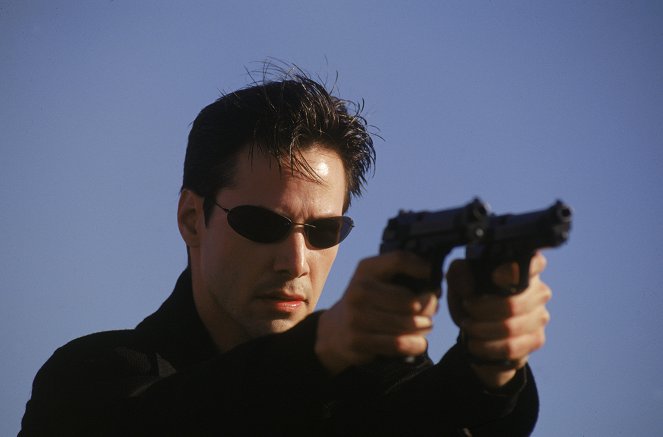
Superhero worlds and other action films after 2010
The Expendables (2010) was a unique throwback to the action films of the 1980s that reunited action legends Sylvester Stallone, Jet Li, Dolph Lundgren and, in small roles, Arnold Schwarzenegger and Bruce Willis, among others, with new stars such as Jason Statham and Randy Couture, who in the sequel, The Expendables 2 (2012), were joined by Jean-Claude Van Damme, Chuck Norris, Scott Adkins and Liam Hemsworth. Charlize Theron became an action star in the thriller Atomic Blonde (2017), and Keanu Reeves made a great name for himself in the film series about the world of assassins John Wick (since 2014). Conceived as one long, wild action scene, Mad Max: Fury Road (2015) set the bar for what a modern action films should look like.
The mantle of the modern action hero was taken by comic book characters. They had first made the transition from paperbacks to television screens and, beginning with the big-budget Superman (1978), began to appear as protagonists in feature films. The X-Men franchise (since 2000) introduced a realistically sober approach to the superhero genre and was followed by Christopher Nolan's dark trilogy Batman Begins (2005), The Dark Knight (2008) and The Dark Knight Rises (2012). The superheroes burst into the open when a connected universe of films that began to emerge in The Avengers series (since 2012), which included Iron Man (since 2008), Thor (since 2011), Captain America: The First Avenger (since 2011), Ant-Man (since 2015), Black Panther (since 2018), and Captain Marvel (since 2019). They were rivalled by the heroes from Justice League (2017), including Superman aka Man of Steel (since 2013), Wonder Woman (since 2017) and Aquaman (since 2018).
The action comedy The A-Team (2010) was based on the TV series of the same name, Jack Reacher (2012) starring Tom Cruise was a huge success, and the Mexican hitman Machete (2010), played by Danny Trejo, also won fans. Gerard Butler established himself in the action series Olympus Has Fallen (2013), London Has Fallen (2016) and Angel Has Fallen (2019). The residence of the American President was also under threat in White House Down (2013). Kingsman: The Secret Service (2014) introduced the heroes of an all-new British spy agency, and Baby Driver (2017) imaginatively combined car chases with a singalong soundtrack. In the video-game-inspired action comedy Guns Akimbo (2019), Daniel Radcliffe roamed the streets with guns nailed to his hands, while in Extraction (2020), a mercenary played by Chris Hemsworth searched for the kidnapped son of a crime boss. Veteran actors Sylvester Stallone and Arnold Schwarzenegger met in Escape Plan (2013), in which they try to escape from an extremely secure prison, and both have since returned to their most famous roles over the years, Stallone as Rambo in Rambo: Last Blood (2019) and Schwarzenegger as Terminator in Terminator: Dark Fate (2019).
The Dark Knight (2008)
Photo © Warner Bros Pictures
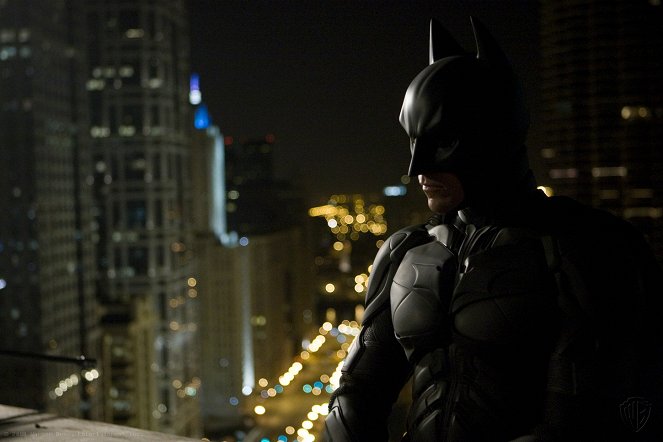
Action TV series
In the 1960s, the American TV series Mission: Impossible (1966-1973) featured special team members who were sent on dangerous and seemingly impossible missions, and it would be remade fifteen years later (1988-1990). In the 1970s, an action-crime series about police partners called Starsky & Hutch (1975-1979) was popular in America, and it was later followed by Miami Vice (1984-1989), about the actions of two undercover police officers. Other popular series were S.W.A.T. (1975-1976), about a special police unit, Charlie's Angels (1976-1981), about a trio of undercover agents, and the action comedy The Dukes of Hazard (1979-1985). In the 1980s, the television screens belonged to The A-Team (1983-1987), in which a quartet of Vietnam veterans became mercenaries fighting for justice, Tom Selleck as the protagonist of Magnum (1980-1988), a private detective and former Marine, David Hasselhoff driving a futuristic talking car in Knight Rider (1982-1986), and MacGyver (1985-1993), starring Richard Dean Anderson as an agent able to improvise his way through any situation.
Series such as Walker, Texas Ranger (1993-2001), Renegade (1992-1997) and the German Alarm für Cobra 11 - Die Autobahnpolizei (from 1996) dominated the TV action genre in the 1990s, until the world saw the revolutionary series 24 (2001-2010), all episodes of which took place in real time, where the protagonist, an anti-terrorist agent played by Kiefer Sutherland, always had only one day to resolve a complicated situation and save his loved ones. Prison Break (2005-2017) also became a phenomenon, following the fate of two brothers trying to escape from prison. Other action series produced after 2000 include Alias (2001-2006), which deals with the story of a double secret agent, Strike Back (since 2010), in which two members of a secret anti-terrorist organisation undertake joint missions, and Into the Badlands (2015-2019), which worked with the poetics of the Chinese wuxia genre and the duelling choreography of the fighters, and Jack Ryan (from 2018), in which John Krasinski plays a CIA analyst who, instead of the safe environment of a desk job, finds himself in the middle of dangerous action.
Filmmaniak
Best action films
Terminator 2: Judgment Day (1991) |
The Lord of the Rings: The Fellowship of the Ring (2001) |
The Lord of the Rings: The Return of the King (2003) |
The Dark Knight (2008) |
The Matrix (1999) |
Raiders of the Lost Ark (1981) |
The Magnificent Seven (1960) |
Indiana Jones and the Last Crusade (1989) |
Ford v Ferrari (2019) |
Rush (2013) |
| All the best action films |
